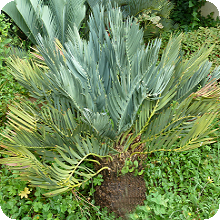| |||
| Division: Cycadophyta |
| Class: Cycadopsida |
| Order: Cycadales |
| Family: Zamiaceae |
| Genus: Encephalartos |
| Species: E. dolomiticus |
Conservation Status: |

E. dolomiticus
Wolkberg CycadThis species is only found in the Wolkberg, near Penge in the Drakensberg in southeastern Limpopo Province, South Africa, occurring on grassland on shallow soils over dolomite ridges. Recorded from 1,100 to 1,500 m. It is an exceptionally rare blue-leaved African cycad close to extinction in the wild. Very desirable collector plant; blue leaves that twist & spiral upwards blue/green cones. Needs excellent drainage. One of the choicest blue cycads, but rarely available.
Leaves: They are 60-80cm long, twisted, recurve, and glaucous green. The leaflets are sharply pointed, 12-16cm long, 1.2-1.4cm broad and may have some teeth on the lower margins. The petiole is 9-14cm long with a red-brown collar at the base of the rachis. A distinct feature is the looseness of the rachis to the base and resembles crown rot or disease.
Stem: Mature plants may reach a height of 0.8-1.2 meters, with a diameter of 25-30cm. Thee crown is covered with soft buff-coloured woolly bracts which are 3-6cm long.
Cones: Female plants normally produce a single (up to 4 has been recorded), large, green cone, 45-50cm in length and 25cm in diameter. Seeds are a pale yellow.
Male cones are produced singly or up to 3, sub cylindrical, 35-50cm long and 5-8.5cm in diameter.
Cultivation:
Very little information is available, but is seems as if this species is not a vigorous grower. Coming from a dry area, it is probably sensitive to over-watering, and transplantation either from the wild or from one garden situation to another is likely to be hazardous. It should always get as much direct sunlight as possible.
| full sun | blue-green | very low watering | slow growth | frost-resistant | rare |
Very little information is available, but is seems as if this species is not a vigorous grower. Coming from a dry area, it is probably sensitive to over-watering, and transplantation either from the wild or from one garden situation to another is likely to be hazardous. It should always get as much direct sunlight as possible.
Available E. dolomiticus at Africa Cycads:
